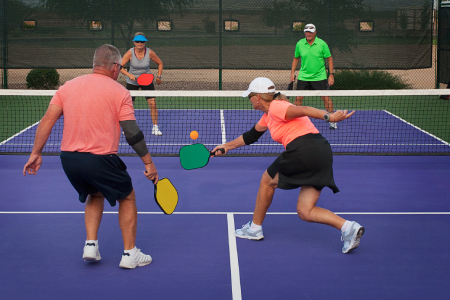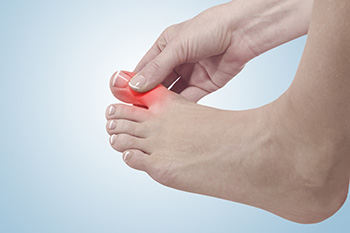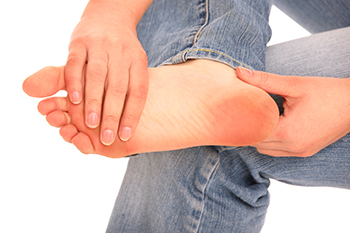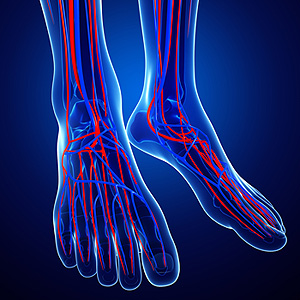Connect With Us
Blog

Pickleball’s rapid rise in popularity has also brought an increase in foot and ankle injuries among players. Quick pivots, sudden lunges, and rapid stops put significant stress on the feet, often leading to plantar fasciitis, ankle sprains, and Achilles tendon ruptures. The Achilles tendon, which connects the calf muscles to the heel, is especially vulnerable during explosive movements causing tears or ruptures. Strains of the peroneal tendons along the outside of the ankle or stress fractures of the metatarsals in the forefoot may result from repetitive pounding on hard surfaces. Mild sprains or bruising can impact stability, making it harder to push off, jump, or change direction. A podiatrist can provide a full evaluation, order imaging if necessary, and offer advanced treatment options to restore mobility and reduce long-term complications. If you are experiencing foot or ankle pain after playing pickleball, it is suggested that you schedule an appointment with a podiatrist for an exam and appropriate treatment.
Sports related foot and ankle injuries require proper treatment before players can go back to their regular routines. For more information, contact Jeffrey Rosenblatt, DPM of New York. Our doctor can provide the care you need to keep you pain-free and on your feet.
Sports Related Foot and Ankle Injuries
Foot and ankle injuries are a common occurrence when it comes to athletes of any sport. While many athletes dismiss the initial aches and pains, the truth is that ignoring potential foot and ankle injuries can lead to serious problems. As athletes continue to place pressure and strain the area further, a mild injury can turn into something as serious as a rupture and may lead to a permanent disability. There are many factors that contribute to sports related foot and ankle injuries, which include failure to warm up properly, not providing support or wearing bad footwear. Common injuries and conditions athletes face, including:
- Plantar Fasciitis
- Achilles Tendinitis
- Achilles Tendon Rupture
- Ankle Sprains
Sports related injuries are commonly treated using the RICE method. This includes rest, applying ice to the injured area, compression and elevating the ankle. More serious sprains and injuries may require surgery, which could include arthroscopic and reconstructive surgery. Rehabilitation and therapy may also be required in order to get any recovering athlete to become fully functional again. Any unusual aches and pains an athlete sustains must be evaluated by a licensed, reputable medical professional.
If you have any questions please contact our office located in Brooklyn, NY . We offer the newest diagnostic and treatment technologies for all your foot and ankle needs.

Gout is a painful form of arthritis caused by the buildup of uric acid crystals in the joints. It often leads to sudden swelling, redness, and intense pain, commonly affecting the big toe. Risk factors include genetics, obesity, a diet high in red meat or alcohol, and certain medical conditions. The big toe is especially vulnerable because it is a cooler area of the body where uric acid crystals are more likely to form. A podiatrist can diagnose gout, manage inflammation, and recommend lifestyle changes to prevent future flare-ups. If you have severe pain in your big toe, it is suggested that you are under the care of a podiatrist who can help you to manage this painful condition.
Gout is a foot condition that requires certain treatment and care. If you are seeking treatment, contact Jeffrey Rosenblatt, DPM from New York. Our doctor will treat your foot and ankle needs.
What Is Gout?
Gout is a type of arthritis caused by a buildup of uric acid in the bloodstream. It often develops in the foot, especially the big toe area, although it can manifest in other parts of the body as well. Gout can make walking and standing very painful and is especially common in diabetics and the obese.
People typically get gout because of a poor diet. Genetic predisposition is also a factor. The children of parents who have had gout frequently have a chance of developing it themselves.
Gout can easily be identified by redness and inflammation of the big toe and the surrounding areas of the foot. Other symptoms include extreme fatigue, joint pain, and running high fevers. Sometimes corticosteroid drugs can be prescribed to treat gout, but the best way to combat this disease is to get more exercise and eat a better diet.
If you have any questions, please feel free to contact our office located in Brooklyn, NY . We offer the newest diagnostic and treatment technologies for all your foot care needs.

Pain on the bottom of the foot can be caused by plantar fasciitis, metatarsalgia, or peripheral neuropathy. Plantar fasciitis involves inflammation of the band of tissue along the arch, causing sharp heel pain, especially in the morning. Metatarsalgia affects the ball of the foot and may feel like a burning or aching sensation worsened by standing or walking. Peripheral neuropathy, often linked to diabetes or nerve damage, can cause tingling, numbness, or shooting pain in the soles of the feet. Each condition appears differently, but all can significantly impact mobility and quality of life. A podiatrist can perform a thorough evaluation, including a physical exam, gait analysis, and imaging if needed, to determine the cause. Treatment may involve custom orthotics, stretching exercises, footwear changes, medications, or specialized therapies. Addressing foot pain early can prevent long-term discomfort and complications. To find lasting relief, it is suggested that you make an appointment with a podiatrist.
Foot Pain
Foot pain can be extremely painful and debilitating. If you have a foot pain, consult with Jeffrey Rosenblatt, DPM from New York. Our doctor will assess your condition and provide you with quality foot and ankle treatment.
Causes
Foot pain is a very broad condition that could be caused by one or more ailments. The most common include:
- Bunions
- Hammertoes
- Plantar Fasciitis
- Bone Spurs
- Corns
- Tarsal Tunnel Syndrome
- Ingrown Toenails
- Arthritis (such as Gout, Rheumatoid, and Osteoarthritis)
- Flat Feet
- Injury (from stress fractures, broken toe, foot, ankle, Achilles tendon ruptures, and sprains)
- And more
Diagnosis
To figure out the cause of foot pain, podiatrists utilize several different methods. This can range from simple visual inspections and sensation tests to X-rays and MRI scans. Prior medical history, family medical history, and any recent physical traumatic events will all be taken into consideration for a proper diagnosis.
Treatment
Treatment depends upon the cause of the foot pain. Whether it is resting, staying off the foot, or having surgery; podiatrists have a number of treatment options available for foot pain.
If you have any questions, please feel free to contact our office located in Brooklyn, NY . We offer the newest diagnostic and treatment technologies for all your foot care needs.
 Morton’s Neuroma—otherwise known as Morton’s metatarsalgia, Morton’s disease and Morton’s neuralgia, is a swollen, non-cancerous growth of nerve tissue that usually clusters between the third and fourth toes. This can cause a good deal of pain, particularly in the ball of the foot. Other symptoms include a burning, tingling, or numbness in the toes, pain while curling the toes, and the sensation of having a pebble in the bottom of your shoe by the ball of the foot. Possible causes of this ailment may consist of wearing high heels regularly and participating in certain sporting activities for extended periods of time. If you are experiencing this kind of pain in the ball of your foot, a podiatrist can examine you and run a series of tests to determine your nerve response and foot function. Treatment methods range from orthotics to injection therapies, and in severe cases surgery may be necessary. It is suggested that you visit a podiatrist as soon as possible if you experience any of the symptoms mentioned.
Morton’s Neuroma—otherwise known as Morton’s metatarsalgia, Morton’s disease and Morton’s neuralgia, is a swollen, non-cancerous growth of nerve tissue that usually clusters between the third and fourth toes. This can cause a good deal of pain, particularly in the ball of the foot. Other symptoms include a burning, tingling, or numbness in the toes, pain while curling the toes, and the sensation of having a pebble in the bottom of your shoe by the ball of the foot. Possible causes of this ailment may consist of wearing high heels regularly and participating in certain sporting activities for extended periods of time. If you are experiencing this kind of pain in the ball of your foot, a podiatrist can examine you and run a series of tests to determine your nerve response and foot function. Treatment methods range from orthotics to injection therapies, and in severe cases surgery may be necessary. It is suggested that you visit a podiatrist as soon as possible if you experience any of the symptoms mentioned.
Morton’s neuroma is a very uncomfortable condition to live with. If you think you have Morton’s neuroma, contact Jeffrey Rosenblatt, DPM of New York. Our doctor will attend to all of your foot care needs and answer any of your related questions.
Morton’s Neuroma
Morton's neuroma is a painful foot condition that commonly affects the areas between the second and third or third and fourth toe, although other areas of the foot are also susceptible. Morton’s neuroma is caused by an inflamed nerve in the foot that is being squeezed and aggravated by surrounding bones.
What Increases the Chances of Having Morton’s Neuroma?
- Ill-fitting high heels or shoes that add pressure to the toe or foot
- Jogging, running or any sport that involves constant impact to the foot
- Flat feet, bunions, and any other foot deformities
Morton’s neuroma is a very treatable condition. Orthotics and shoe inserts can often be used to alleviate the pain on the forefront of the feet. In more severe cases, corticosteroids can also be prescribed. In order to figure out the best treatment for your neuroma, it’s recommended to seek the care of a podiatrist who can diagnose your condition and provide different treatment options.
If you have any questions, please feel free to contact our office located in Brooklyn, NY . We offer the newest diagnostic and treatment technologies for all your foot care needs.
Blog Archives
- October 2025
- September 2025
- August 2025
- July 2025
- June 2025
- May 2025
- April 2025
- March 2025
- February 2025
- January 2025
- December 2024
- November 2024
- October 2024
- September 2024
- August 2024
- July 2024
- June 2024
- May 2024
- April 2024
- March 2024
- February 2024
- January 2024
- December 2023
- November 2023
- October 2023
- September 2023
- August 2023
- July 2023
- June 2023
- May 2023
- April 2023
- March 2023
- February 2023
- January 2023
- December 2022
- November 2022
- October 2022
- September 2022
- August 2022
